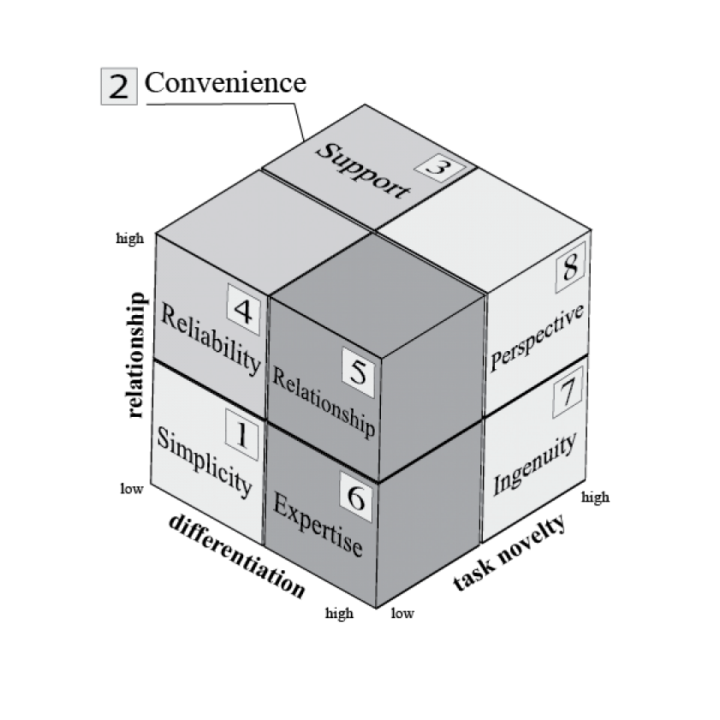There is a straightforward way to create more value for your clients should you decide that is what you actually want to do. And no, it doesn’t involve discounting or doing more work for free. The concept of value goes far beyond economic value of cost savings and top line improvement.
Defining Client Aims, Goals and Strategies
It all starts with a realization that it isn’t only deliverables, and it isn’t only outcomes your clients are buying. Yes, sometimes the only thing they want from you is a deliverable and nothing else. “Draft us a bloody distribution agreement with Schedule A by Monday. Make it no more than five pages long, and send over the bill.”
However, in many cases, especially when the job at hand involves emotions, complexity, uncertainty, higher stakes, there are other forces at play. Namely, motivations, goals and aims.
When they reach out to you, buyers often have aims whether they can define them explicitly or not. They often arrive with specific goals in mind as well, albeit oftentimes specified incorrectly. And they often have some notion of a strategy developed to hit their goals.
There are smart goals and there are stupid goals.
Let’s set the record straight first: aims and goals are not the same thing. Aim is a direction. It may be vague but it exists. Goals are destinations. There are smart goals and there are stupid goals. The ones in the vicinity of an aim are doable, thus smart. The latter ones are too far off, therefore hard to bridge, hence will be perceived as unlikely to attain.
Strategy is akin to a serpentine path along that overall direction (aim). It unfolds in an attempt to touch, grasp or envelop those destinations (goals). When you conceptualize it this way, you will immediately recognize that your services are your clients’ strategy. If you keep working on hitting stupid goals, it doesn’t really matter how smart your strategy turns out to be.
Because buyers are often terrible at specifying the right goals for themselves as well as identifying the most appropriate strategy for their attainment, it is your opportunity (if not duty) to help them align the two with the Aim Value in mind. If we allow Aim Value, goals and strategy to remain misaligned, finger pointing and frustrations are unavoidable. Also, such incongruence often leads to devastating results.Your services are your clients’ strategy.
Consider the Knives Out movie. The main protagonist, Mr. Thrombey a HNWI disinherits his whole family by changing his will only to be murdered a week later. The deceased chose a strategy befitting someone motivated by anger, bitterness and resentment. How else would you explain the fact of disinheriting every single family member, and leaving the whole estate to a caretaker?
However, his actual motivations were actually very different, namely accomplishment and achievement. And one of his goals was to help his son — Walt — write his own book. Therefore, HNWI’s strategy should’ve been different — something other than disinheriting everyone thus inevitably breeding resentment. Because Mr. Thrombey failed to align aim, goal and strategy, the consequences turned out to be literally deadly.
Accomplishment and achievement are the two motivations that drive behavior of the following two generic buyer types: Convenience and Expertise buyer respectively (see Figure 1). If this wasn’t a matter of a will (think of any other service), the personal lawyer Mr. Stevens should’ve recognized the misalignment between the Aim Value, goals and strategy, offering to rectify that, thus creating more value for the client.

Creating more Value for Clients
At your professional firm, you can create more value when you help your clients align their aims, goals and strategy. Let’s say your client’s Aim Value is to become a renown archer one day — a silly example but sufficient to paint the right picture. They have a vision for the future that is in accord with their Aim Value: to win an Olympic gold in the current tournament.
They’ve entered the competition and now choose to aim at a nearby target #11 which is slightly offside their own lane numbered #10. They bootstrap their shoes and start walking toward that target with a clear intention of inserting the arrow dead center into that golden circle. At this point, as their coach or trusted advisor, you should immediately slap them (figuratively speaking), urging them to come to their senses.
If they were to proceed with their selected target #11 as well as their strategy of efficiently carrying the arrow, they would’ve been disqualified. In other words, because they were actually supposed to hit the target directly opposite their position which is #10, the client would’ve violated their Aim Value by missing the correct target (goal). In addition, their strategy was supposed to be shooting arrows rather than pompously carrying them around.
As a trusted advisor, you can help your clients align the three, thus creating more value for them. Like I said, this is a silly example. But it paints a vivid picture of misalignment. When strategy (shooting arrows), goals (at target #10), vision (to win the tournament), and Aim Value (thus getting closer to becoming a renowned archer one day) are aligned, the whole enterprise becomes much more valuable. Each part contributes to the whole and facilitates movement in desirable direction.
To figure out what your client’s Aim Value is, you need to monitor their behavior: what words they use, what trade-offs they absorb, and so on. Because behavior is regulated by motivation, which also erects perceptual frames, observing behaviors helps with figuring out which buyer type you’re dealing with. Hence, much easier to negotiate value components (there are several categories of those) that will be perceived is actually valuable. This will also allow you to remove value components which will be perceived as obstacles. And, of course, dial down irrelevant value components, thus effectively controlling your cost structure.
The awezzom question of the day:
How do we assess alignment of our clients’ aims, goals and strategies so that we can create more value for them?

